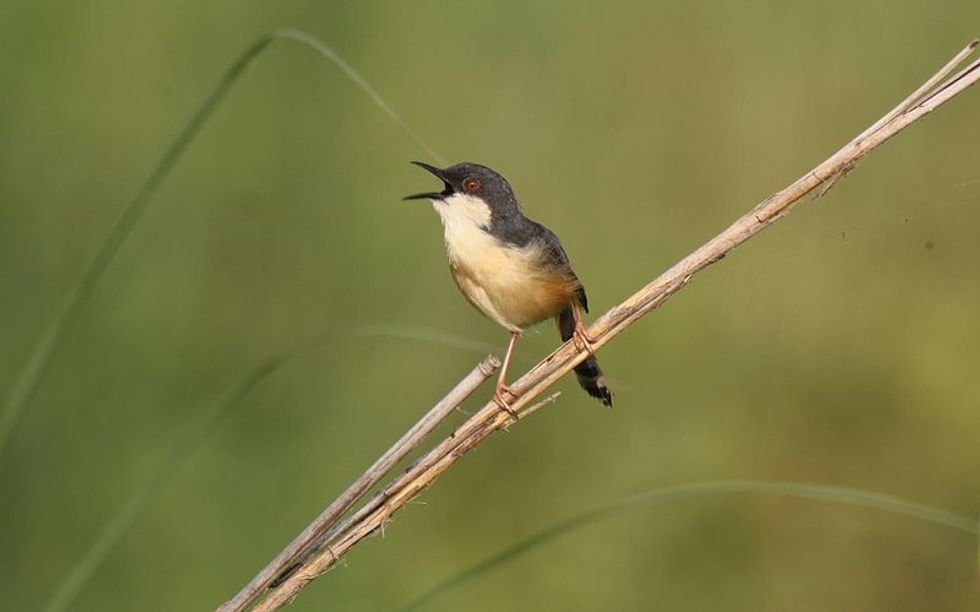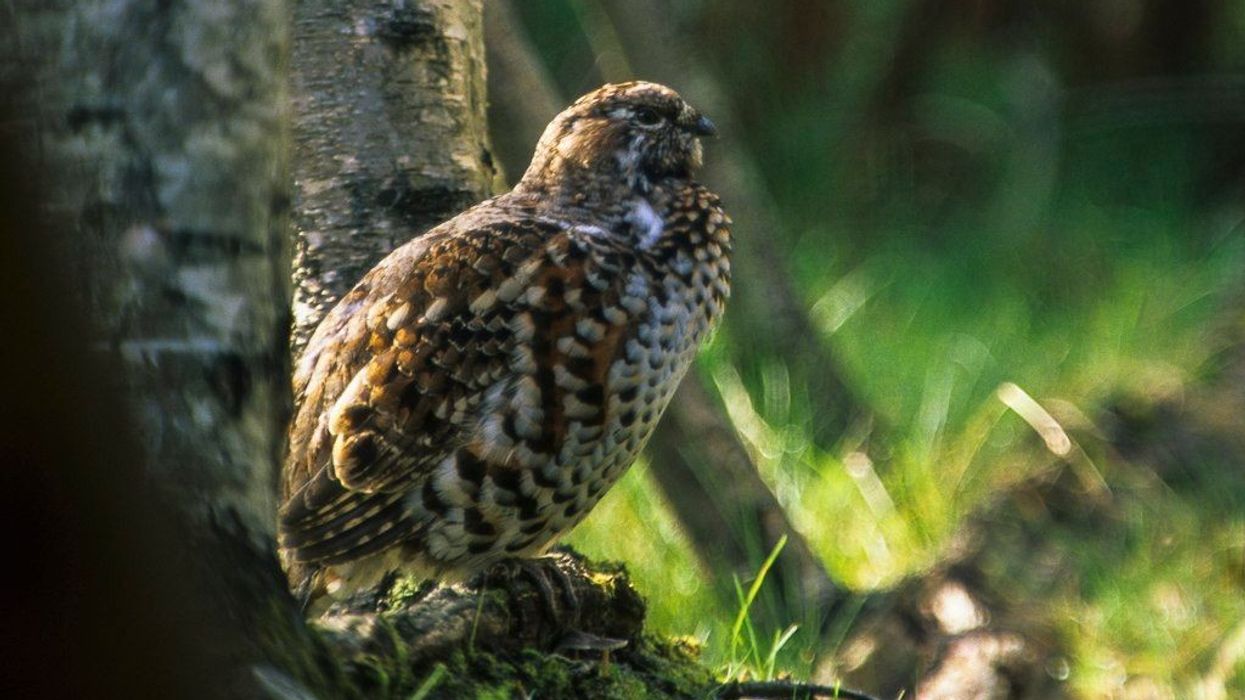If your kids give you the googly eyes when they see tiny birds hopping around, then they will enjoy exploring these Ashy Prinia facts. These bouncy birds look the prettiest when they are perched with upright tails, which they twitch now and then.
The natural gray highlight on the back of these birds gives it a sleek finish while also making its cushion-like breast stand out.
The song of the Ashy Prinia (Prinia socialis) species is not out of the ordinary but prominently identifiable. The bird prefers woodlands and grasslands and is also found in urban gardens across several regions in Asian countries such as India, Nepal, Pakistan, and Bhutan.
These birds mate for life, and the pairs incubate their eggs, search for food and feed their young in turns.
The Ashy Prinia (Prinia socialis) is an insectivore like other warblers, but they also have a sweet tooth for nectar-producing flowers. This bird species also show color variation in its plumage during the breeding and non-breeding seasons.
If these chirpy minions have left you thinking about other birds, do have a look at the Blue jay and Palm cockatoo.
Ashy Prinia Interesting Facts
What type of animal is an Ashy Prinia?
The Ashy Wren Warbler (Prinia socialis) is a small flight bird and is a resident breeder of the Indian subcontinent.
What class of animal does an Ashy Prinia belong to?
The Ashy Prinia (Prinia socialis), along with other warblers, comprise the family of Cisticolidae under the order Passeriformes and the class Aves and genus Prinia.
How many Ashy Prinias are there in the world?
Although the count for the Ashy Wren Warbler (Prinia socialis) population is unavailable, it is a fairly common resident bird across many Asian countries in the warmer southern region. In addition, according to the IUCN, the Ashy Prinia range map is quite large and proves that they have a stable population distribution.
Where does an Ashy Prinia live?
The Ashy Prinia (Prinia socialis) lives in the Indian subcontinent, Pakistan, Nepal, Bhutan, Myanmar, Bangladesh, and Sri Lanka. They are not migratory birds.
What is an Ashy Prinia's habitat?
The Ashy Prinia habitat includes open grasslands as well as woodlands. They are found in plain scrubs and bushy gardens across urban regions. Large populations of these birds inhabit the foothills of the Himalayas, the Indus river system, and the lowlands of Sri Lanka. However, when this bird nests, it prefers breeding near the ground in grass or shrubs.
Who does Ashy Prinias live with?
The Ashy Prinia or Ashy Wren Warbler (Prinia socialis) is solitary until it finds a mate. Although these birds are monogamous, they roost separately on branches of shrubbery or small trees.
How long does an Ashy Prinia live?
The Ashy Prinia or Ashy Wren Warbler has a lifespan of around 10 years.
How do they reproduce?
The Ashy Prinia has been breeding and making tiny babies all year long, but the numbers peak after the monsoons in June. Usually, this resident breeder starts nesting from June to September in northern and western India, and December to March as well as August to October in Sri Lanka.
The mating call is sung by the Ashy Prinia male (Prinia socialis) with a fantastic display of twitching, an upright tail, and various flight movements.
The female takes responsibility for the nest and builds near the ground, hidden in shrubbery or tall grass.
The nest of these birds is unevenly sewn together and has somewhat of a flimsy appearance. They use large leaves, grass, stems, and twigs held together with hair and webs to create an oblong-shaped exterior with an opening on the side.
Later, the inside of the nest is stuffed with a fluffy ball of messy grass. The Ashy Prinia female lays around three to five shiny auburn-colored eggs and is incubated for about 12 days before they hatch.
Together, the male and female work in pairs and take turns to incubate the eggs and feed the hatchlings.
What is their conservation status?
Considering the stability in the distribution of the Ashy Prinia (Prinia socialis), especially across India, the IUCN has given the Least Concern status to this bird.
Ashy Prinia Fun Facts
What does Ashy Prinias look like?
Belonging to the family of around 160 warblers, the Ashy Prinia (Prinia socialis Sykes, 1832) is a small bird with a semi-elongated body, a pointy black bill, tapering tail with details of contrasting stripes, and round, plain stubby wings.
These birds are famous for hopping around the ground with their tails hoisted and occasionally fluttering it as they move around.
The typical plumage of an Ashy Prinia (Prinia socialis) consists of gray feathers running from the forecrown along the back, reddish-brown wings, and whitish with a hint of rufous underneath.
Sometimes during the non-breeding season, these birds display a fine white line of feathers from the beak to the crown, also known as supercilium.
Their tails also show an increase in length. Some of the subspecies show seasonal variations in their plumage during summers and after the monsoons.

How cute are they?
The Ashy Prinia (Prinia socialis) species is almost like a local garden ornament. They are constantly hopping and flicking their tails in an up-and-down motion, just like the Spotted sandpiper. With these behavioral characteristics, this bird is quite interesting and cute to admire.
How do they communicate?
The Ashy Prinia (Prinia socialis) is one of the species often heard singing a repetitive 'tchup, tchup,' or 'zeet-zeet' sound. Sometimes these birds also produce a variation that sounds like a continuous nasal 'tee-tee' noise.
When in flight, you will hear another Ashy Prinia call which sounds like a periodic electric buzz. Although it's up for debate, some say that the birds make this sound by fluttering their wings, while others suggest the noise is produced with the beak.
How big is an Ashy Prinia?
The Ashy Prinia adults are around the same size as the European robin, but the physical characteristics of these birds are quite different. The Prinia socialis is almost triple in size when compared to the Bee hummingbird.
How fast can an Ashy Prinia fly?
The exact speed at which the Ashy Prinia (Prinia socialis) flies has not been recorded. However, from observations, you can tell that they are quite swift and sometimes fly in jerky movements.
How much does an Ashy Prinia weigh?
The Ashy Prinia (Prinia socialis) is one of the tropical and subtropical Old World birds that negligibly weighs 0.2-0.3 oz (7-10 g).
What are the male and female names of the species?
The male and female counterparts of the Ashy Prinia, Sykes 1832 are not given separate names.
What would you call a baby Ashy Prinia?
The Ashy Prinia (Prinia socialis) baby is called a chick like the hatchlings of other birds.
What do they eat?
The Ashy Prinia diet is mostly insectivorous, but they do feed on nectar as well. They feed insects like earthworms, larvae, small spiders, flies, mosquitoes, termites, weevils, and so on.
Are they rare?
Although the Ashy Prinia (Prinia socialis) distribution is not even all over the world, they are a common bird species in parts of India, Sri Lanka, Nepal, and several other south Asian countries.
Would they make a good pet?
The Ashy Prinia (Prinia socialis) is not a family bird that can be kept as a pet. It lives best in its natural habitat, often found in a bush or plants close to the ground.
Did you know...
The Ashy Prinia sound, which is similar to that of an electric buzz, is produced when they fly.
Some of the subspecies of the Ashy Prinia (Prinia socialis) show a biannual molt during spring and autumn.
The Ashy Prinia (Prinia socialis) eggs are as tiny as 0.6-0.7 in (1.5-1.7 cm) in length.
During cold months, the parents Ashy Prinia (Prinia socialis), spend more time near their nests.
Brood parasites such as the plaintive cuckoo and gray-bellied cuckoo use the nests of the Ashy Prinia (Prinia socialis) to raise their young ones.
What's the difference between an Ashy Wren Warbler and Palm Warbler?
Despite the names of these birds, the Ashy Wren Warbler (Prinia socialis) and the Palm Warbler are quite different.
For instance, the Palm Warbler species belongs to the family Parulidae and genus Setophaga, whereas the Ashy Prinia belongs to the family Cisticolidae and genus Prinia.
In addition, the Palm Warbler's geographic distribution is found across Canada, the United States, the Caribbean Islands, Nicaragua, and Panama. These birds are dressed in brown and yellow feathers with spotted details, which is a stark difference from the plumage of the Ashy Prinia (Prinia socialis).
Another difference between these species is noticed in their call in that the Ashy Prinia makes a repetitive 'tchup tchup' or 'zeet zeet' sound, and the Palm Warbler sings 4-16 buzzy notes that gradually increase in pitch.
How did the Ashy Prinia get its name, and what other names does it have?
There is no proven explanation behind the name origin of the Ashy Prinia (Prinia socialis). The most plausible derivation of its name is its ash-gray color.
The Ashy Prinia has many interchangeable names, such as the Ashy Wren Warbler and Prinia socialis, Sykes 1832. This bird family also has a variation in regional names that differ based on the subspecies of the bird.
Here at Kidadl, we have carefully created lots of interesting family-friendly animal facts for everyone to discover! Learn more about some other birds from our Palm Warbler Facts or Mourning Warbler Facts pages.
You can even occupy yourself at home by coloring in one of our free printable Ashy prinia coloring pages.









